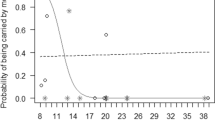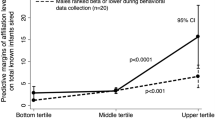Summary
Data from a long-term field study of the spider monkey, Ateles paniscus, in Peru indicate that a strongly female-biased sex ratio exists from birth in this population. Of 46 infants born between July 1981 and June 1986, 12 were male, 32 were female and 2 were of undetermined sex. This effect is consistent between years as well, with more females than males born in each year of the study (Table 1). This bias is driven by the fact that low-ranking females produce daughters almost exclusively, while high-ranking females bias their investment somewhat less strongly towards sons (Table 2). The unusual pattern of female-biased maternal investment observed in this population of Ateles probably occurs for a combination of the following reasons: (1) maternal investment in individual male offspring is somewhat greater than in individual female offspring; (2) males remain with their natal groups, and the sons of high-ranking females are likely to be competitively superior to the sons of low-ranking females; (3) males compete for mates, and only the one or two most dominant males within a community are likely to achieve significant reproductive success. Two possible mechanisms of sex-ratio adjustment and the evidence for each are discussed.
Similar content being viewed by others
References
Altmann J (1980) Baboon mothers and infants. Harvard University Press, Cambridge
Cant JGH (1978) Population survey of the spider monkey Ateles geoffroyi at Tikal, Guatemala. Primates 19:325–335
Carpenter CR (1935) Behavior of red spider monkeys in Panama. J Mammol 16:171–180
Clark AB (1978) Sex ratio and local resource competition in a prosimian primate. Science 201:163–165
Clutton-Brock TH (1982) Sons and daughters. Nature 298:11–13
Clutton-Brock TH, Albon SD (1982) Parental investment in male and female offspring in mammals. In: King's College Sociobiology Group (eds) Current problems in sociobiology. Cambridge University Press, Cambridge, pp 223–247
Clutton-Brock TH, Harvey PH (1977) Primate ecology and social organization. J Zool (Lond) 183:1–39
Clutton-Brock TH, Albon SD, Guiness FE (1981) Parental investment in male and female offspring in polygynous mammals. Nature 289:487–489
Clutton-Brock TH, Guiness FE, Albon SD (1982) Red deer. University of Chicago Press, Chicago
Clutton-Brock TH, Albon SD, Guiness FE (1986) Great expectations: dominance, breeding success and offspring sex ratios in red deer. Anim Behav 34:460–471
Coelho AM, Bramblett CA, Quick LB (1979) Activity patterns in howler and spider monkeys: an application of some sociobioenergetic methods. In: Bernstein IS, Smith EO (eds) Primate ecology and human origins. Garland, New York, pp 175–200
Dittus WPJ (1979) The evolution of behaviors regulating density and age-specific sex ratios in a primate population. Behaviour 69:265–301
Fisher RA (1958) The genetical theory of natural selection. Dover Publications, New York
Goodall J (1983) Population dynamics during a 15 year period in one community of free-living chimpanzees in the Gombe National Park, Tanzania. Z Tierpsychol 61:1–60
Hamilton WD (1967) Extraordinary sex ratios. Science 156:477–488
Hiraiwa-Hasegawa M, Hasegawa T, Nishida T (1984) Demographic study of a large-sized unit group of chimpanzees in the Mahale Mountains, Tanzania: a preliminary report. Primates 25:401–413
Holdridge LR (1967) Life zone ecology. Propical Science Center, San Jose, Costa Rica
Kano T (1982) The social group of pygmy chimpanzees (Pan paniscus) of Wamba. Primates 23:171–188
Klein LL, Klein DB (1977) Feeding behaviour of the Colombian spider monkey. In: Clutton-Brock TH (ed) Primate ecology. Academic Press, London, pp 154–181
Kuroda S (1979) Grouping of the pygmy chimpanzees. Primates 20:161–183
Maurer RR, Foote RH (1971) Maternal aging and embryonic mortality in the rabbit. J Reprod Fertil 25:329–341
McFarland MJ (1986) Ecological determinants of fission-fusion sociality in Ateles and Pan. In: Lee PC, Else J (eds) Primate Ecology and Conservation. Cambridge University Press, Cambridge, pp 181–190
McMillen MM (1979) Differential mortality by sex in fetal and neonatal deaths. Science 204:89–91
Meikle DB, Tilford BL, Vessey SH (1984) Dominance rank, secondary sex ratio, and reproduction of offspring in polygynous primates. Am Nat 124:173–188
Nishida T (1968) The social group of wild chimpanzees in the Mahali Mountains. Primates 9:167–224
Paul A, Thommen D (1984) Timing of birth, female reproductive success and infant sex ratio in semifree-ranging Barbary macaques (Macaca sylvanus). Folia Primatol 42:2–16
Reiter J, Stinson NL, LeBoeuf BJ (1978) Northern elephant seal development: the transition from weaning to nutritional independence. Behav Ecol Sociobiol 3:337–367
Robinette WL, Geshwiler JB, Low JB, Jones DA (1957) Differential mortality by sex and age among mule deer. J Wildl Manage 21:1–16
van Roosmalen MGM (1982) Habitat preferences, diet, feeding behavior and social organization of the black spider monkey, Ateles paniscus paniscus in Surinam. Unpublished PhD thesis, University of Wageningen, Netherlands
van Schaik CP, van Noordwijk MA (1983) Social stress and the sex ratio of neonates and infants among non-human primates. Neth J Zool 33:249–265
Silk JB (1983) Local resource competition and facultative adjustment of sex ratios in relation to competitive abilities. Am Nat 121:56–66
Silk JB, Clark-Wheatley CB, Rodman PS, Samuels A (1981) Differential reproductive success and facultative adjustment of sex ratios among captive female bonnet macaques (Macaca radiata). Anim Behav 29:1106–1120
Simpson AE, Simpson MJA (1985) Short-term consequences of different breeding histories for captive rhesus macaque mothers and young. Behav Ecol Sociobiol 18:83–89
Simpson MJA, Simpson AE (1982) Birth sex ratios and social rank in rhesus monkey mothers. Nature 300:440–441
Sundell G (1962) The sex ratio before uterine implantation in the golden hamster. J Emb Exp Morph 10:58–63
Terborgh J (1983) Five New World primates. Princeton University Press, Princeton
Trivers RL, Willard DE (1973) Natural selection of parental ability to vary the sex ratio of offspring. Science 179:90–92
Williams GC (1979) The question of adaptive sex ratio in outcrossed vertebrates. Proc R Soc Lond B 205:567–580
Author information
Authors and Affiliations
Rights and permissions
About this article
Cite this article
Symington, M.M. Sex ratio and maternal rank in wild spider monkeys: when daughters disperse. Behav Ecol Sociobiol 20, 421–425 (1987). https://doi.org/10.1007/BF00302985
Received:
Accepted:
Issue Date:
DOI: https://doi.org/10.1007/BF00302985




